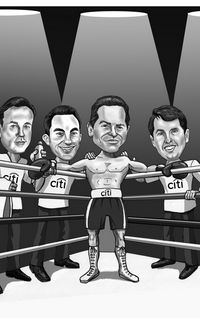Making the right call: After six months without a major IPO in Europe, cable operator Ziggo stormed to market with an increased float, top of the range pricing and positive aftermarket. For perfect co-ordination between banks, private equity – and even an independent adviser – Ziggo’s €924.9m IPO is IFR’s EMEA Equity Issue of the Year.
To see the full digital edition of the IFR Review of the Year, please <a href="http://edition.pagesuite-professional.co.uk//launch.aspx?eid=24f9e7f4-9d79-4e69-a475-1a3b43fb8580" onclick="window.open(this.href);return false;" onkeypress="window.open(this.href);return false;">click here</a>.
When European bankers first began contemplating prospective deals for 2012, it was in the knowledge that no IPO over US$50m had priced since the previous July. Indeed, the market was littered with other companies that had tried to list and failed.
Private equity firms Cinven and Warburg Pincus had mandated banks to float Dutch cable operator Ziggo in March 2011, but thought better of braving the market at that time. Instead, they worked with the banking syndicate of joint global co-ordinators JP Morgan and Morgan Stanley and joint bookrunners Deutsche Bank and UBS to introduce the company to investors.
Initially, there were to be three bookrunners, but the importance of UBS’s research saw the bank upgraded. Advising the sponsors was STJ Advisors. Also on the syndicate were ABN AMRO, HSBC, Nomura and Rabobank as joint lead managers with Societe Generale as co-lead manager.
By early 2012, the pre-work made the listing much easier to pull off.
”By the time the company came to market, management had met substantially all of the key opinion formers on the buyside, many of them on multiple occasions,” said Simon Begg, managing director, capital markets at Warburg Pincus.
The dialogue between banks and investors, and the steady stream of cable assets to market in Europe over previous years, meant banks were optimistic the asset could sell.
“We told the sponsors ‘forget what you read about the market in the press, this deal will fly. The general market sentiment doesn’t matter in this case, investors want cable, and they want Dutch assets’,” said Henrik Gobel, co-head of European ECM at Morgan Stanley.
The IPO launched on February 29, a week after the SIX Swiss Exchange float of outsourcing company DKSH, but a compressed timetable meant Ziggo finished just hours after the Swiss deal. The groundwork ensured the €577.5m–€647.5m deal was covered after just one day. From then on, it was a matter of building momentum.
It became a case of managing demand. The deal was due to price on March 20, but was brought forward by 24 hours as the book grew. Perhaps more importantly, the decision to price at the top of €16.50–€18.50 was made and communicated to investors a few days before.
On the final day of bookbuilding, the base deal was upsized from 35m shares to 43.4m to raise €804.3m. Once the greenshoe was exercised, a deal that began at potentially €577.5m had raised €924.9m. Step-by-step the deal had grown once there was clear market appetite.
“We structured the IPO with a relatively small initial free-float with the objective of showing the market that we continued to believe in the growth trajectory of the company,” said Matthew Sabben-Clare, a partner at Cinven. “Even after the upsize, we still only floated 25% of the company, showing that we as sponsors would be aligned over time with public investors buying the stock.”
Banks in 2011 allocated as many investors as possible to reward them for participating in deals in difficult markets, but that strategy often backfired as investors dumped their meagre allocation. Lesson learnt, this time they were brutal as more than half the book received nothing – the upsize saw allocations increase, but not the number of investors involved.
The aftermarket supported the decision with an opening print of €21.20 – some 14.6% above the IPO price – before closing at €21.25.
Continued gains allowed for the early release of the six-month lock-up at the end of July for the first follow-on. Again sellers and bankers worked together to match the deal to market demand, this time using a greenshoe to remove concerns about summer trading volumes. In late October another lock-up, complete with greenshoe, followed.
In the space of seven months, the sellers extracted €2.67bn from their investment.


